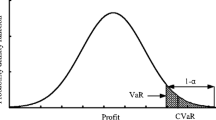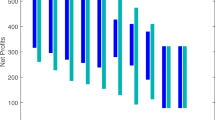Abstract
In this study, a risk aversion based interval stochastic programming (RAIS) method is proposed through integrating interval multistage stochastic programming and conditional value at risk (CVaR) measure for tackling uncertainties expressed as probability distributions and intervals within a multistage context. The RAIS method can reflect dynamic features of the system conditions through transactions at discrete points in time over the planning horizon. Using the CVaR measure, RAIS can effectively reflect system risk resulted from random parameters. When random events are occurred, the adjustable alternatives can be achieved by setting desired targets according to the CVaR, which could make the revised decisions to minimize the economic penalties. Then, the RAIS method is applied to planning agricultural water management in the Zhangweinan River Basin that is plagued by drought due to serious water scarcity. A set of decision alternatives with different combinations of risk levels employed to the objective function and constraints are generated for planning water resources allocation. The results can not only help decision makers examine potential interactions between risks under uncertainty, but also help generate desired policies for agricultural water management with a maximized payoff and a minimized loss.


















Similar content being viewed by others
Abbreviations
- I :
-
Crop, i = 1, 2, 3, I
- j :
-
Subarea, j = 1, 2,…, 15, J
- t :
-
Planning time period, t = 1, 2,…, 5, T
- k :
-
Scenario of reservoir inflow, k = 1, 2,…, 5 representing very-low, low, medium, high and very-high levels respectively
- f ± :
-
Expected system benefit over the planning horizon (RMB¥)
- IB ± ijt :
-
Irrigation benefit for crop i in subarea j per unit of planting area (RMB¥/ha)
- IT ± ijt :
-
Fixed surface-water irrigation target of crop i in subarea j during period t (ha)
- p tk :
-
Probability level under scenario k during period t
- IP ± ijt :
-
Reduction of benefit (economic penalty) to subarea j planting crop i per unit of area not irrigated during period t (RMB¥/ha)
- ISD ± ijtk :
-
Cropland that cannot be irrigated by the surface water under scenario k (ha)
- W ± ijt :
-
Irrigation quota for crop i in subarea j during period t (m3)
- W ± ij(t−1) :
-
Irrigation quota for crop i in subarea j during period t − 1(m3)
- IQ ± tk :
-
Water available for irrigation in Yuecheng Reservoir under scenario k during period t (m3)
- IQ ±(t−1)k :
-
Water available for irrigation in Yuecheng Reservoir under scenario k during period t − 1 (m3)
- ɛ ±(t−1)k :
-
Surplus flow when water is delivered in period t−1 under scenario k (m3), and assuming no spilling for reservoir
- ɛ ±(t−2)k :
-
Surplus flow when water is delivered in period t − 2 under scenario k (m3), and assuming no spilling for reservoir
- IT ± ijtmax :
-
Maximum area that crop i should be planted in subarea j during period t (ha)
- λ :
-
Weight coefficient between cost and risk
- ξ :
-
The biggest system loss under the given confidence level (RMB¥)
- α :
-
Confidence interval
- v ± tk :
-
Instrumental variables
- CWR ± ijt :
-
Amount of water requirement of crop i in subarea j during period t (m3/ha)
- D ± ijt :
-
Average root depth of crop i in period t (m)
- D ± ij(t+1) :
-
Average root depth of crop i in period t + 1 (m)
- θ ± ijt :
-
Soil moisture content of crop i in subarea j in period t (m3/m)
- θ ± ij(t+1) :
-
Soil moisture content of crop i in subarea j in period t + 1 (m3/m)
- θ ± ijtmax :
-
Maximum soil moisture content of crop i in subarea j (m3/m)
- θ ± ijtmin :
-
Minimum soil moisture content of crop i in subarea j (m3/m)
- Ep ± jt :
-
Amount of effective precipitation of crop i in subarea j in period t (m3/ha)
- Ep ±0jt :
-
Amount of actual precipitation of crop i in subarea j in period t (m3/ha)
- Ec ± jt :
-
Evaporation capacity of crop i in subarea j in period t (m3/ha)
- SR ± jt :
-
Surface runoff of crop i in subarea j in period t (m3/ha)
- UR ± jt :
-
Underground runoff of crop i in subarea j in period t (m3/ha)
- DP ± ijt :
-
Deep percolation for crop i in subarea j during the period t (m)
References
Agliardi E, Pinar M, Stengos T (2016) Air and water pollution over time and industries with stochastic dominance. Stoch Environ Res Risk Assess. https://doi.org/10.1007/s00477-016-1258-y
Alberto MCR, Quilty JR, Buresh RJ, Wassmann R, Haidar S et al (2014) Actual evapotranspiration and dual crop coefficients for dry-seeded rice and hybrid maize grown with overhead sprinkler irrigation. Agric Water Manag 136:1–12
Allen RG (2000) Using the FAO-56 dual crop coefficient method over an irrigated region as part of an evapotranspiration intercomparison study. J Hydrol 229:27–41
Amarasingha RPRK, Suriyagoda LDB, Marambe B et al (2015) Modelling the impact of changes in rainfall distribution on the irrigation water requirement and yield of short and medium duration rice varieties using APSIM during Maha season in the dry zone of Sri Lanka. Trop Agric Res 26(2):274–284
Cameron B, Damowski J (2015) Empowering marginalized communities in water resources management: addressing inequitable practices in Participatory Model Building. J Environ Manag 153:153–162
Casey MS, Sen S (2005) The scenario generation algorithm for multistage stochastic linear programming. Math Oper Res 30(3):615–631
Chen F, Huang GH, Fan YR (2015) Inexact multistage fuzzy-stochastic programming model for water resources management. J Water Resour Plan Manag 141(11):04015027
Davijani MH, Banihabib ME, Anvar A, Nadjafzadeh Hashemi SR (2016) Optimization model for the allocation of water resources based on the maximization of employment in the agriculture and industry sectors. J Hydrol 533:430–438
Gulpinar N, Rustem B, Settergren R (2002) Multistage stochastic programming in computational finance. Computational methods in decision making, economics and finance: optimization models. Kluwer Academic Publishers, Dordrecht, pp 33–45
He J (2016) Probabilistic evaluation of causal relationship between variables for water pollution control. J Environ Inf 28(2):110–119
Huang GH (1996) IPWM: an interval parameter water quality management model. Environ Optim A35 26(2):79–103
Hughes DA, Slaughter AR (2016) Disaggregating the components of a monthly water resources system model to daily values for use with a water quality model. Environ Model Softw 80:122–131
Josh RS (2015) Testing the expectations hypothesis with survey forecasts: the impacts of consumer sentiment and the zero lower bound in an I(2) CVAR. J Int Financ Mark Inst Money 35:85–101
Kouwenberg R (2001) Scenario generation and stochastic programming models for asset liability management. Eur J Oper Res 134(2):279–293
Li YP, Huang GH (2011) Planning agricultural water resources system associated with fuzzy and random features. J Am Water Resour Assoc 47(4):841–860
Li YP, Huang GH, Nie SL (2006) An interval-parameter multi-stage stochastic programming model for water resources management under uncertainty. Adv Water Resour 29:776–789
Li YP, Huang GH, Nie SL, Liu L (2008a) Inexact multistage stochastic integer programming for water resources management under uncertainty. J Environ Manag 88:93–107
Li S, Kang S, Li F, Zhang L (2008b) Evapotranspiration and crop coefficient of spring maize with plastic mulch using eddy covariance in northwest China. Agric Water Manag 95(11):1214–1222
Liu J, Li YP, Huang GH, Zeng XT (2014) A dual-interval fixed-mix stochastic programming method for water resources management under uncertainty. Resour Conserv Recycl 88:50–66
Maryam S, Reza K, Mohammad RN, Hamideh N (2016) A conditional value at risk-based model for planning agricultural water and return flow allocation in river systems. Water Resour Manag 30(1):427–443
Melkonyan A (2015) Climate change impact on water resources and crop production in Armenia. Agric Water Manag 161:86–101
Mohammed M, Mac Kirby M, Qureshi E (2007) Integrated hydrologic-economic modeling for analyzing water acquisition strategies in the Murray River Basin. Agric Water Manag 93(1):123–135
Nematian J (2016) An extended two-stage stochastic programming approach for water resources management under uncertainty. J Environ Inf 27(2):72–84
Olivera-Guerra L, Mattar C, Galleguillos M (2014) Estimation of real evapotranspiration and its variation in Mediterranean landscapes of central-southern Chile. Int J Appl Earth Obs Geoinf 28:160–169
Rockafellar RT, Uryasev S (2002) Conditional value-at-risk for general loss distributions. J Bank Finance 26(7):1443–1471
Sirangelo B, Caloiero T, Coscarelli R, Ferrari E (2015) A stochastic model for the analysis of the temporal change of dry spells. Stoch Environ Res Risk Assess 29(1):143–155
Suinyuy DN, Xiong ZX, Presley K, Wesseh J (2016) Signatures of water resources consumption on sustainable economic growth in sub-Saharan African countries. Int J Sustain Built Environ 112:1375–1385
Vipan K, Theophilus K, Udeigwe EL, Clawson RV, Rohli DK, Miller DK (2015) Crop water use and stage-specific crop coefficients for irrigated cotton in the mid-south, United States. Agric Water Manag 156:63–69
Wang YY, Huang GH, Wang S, Li W, Guan PB (2016) A risk-based interactive multi-stage stochastic programming approach for water resources planning under dual uncertainties. Stoch Envitron Res Risk Assess 94:217–230
Wherley B, Dukes MD, Cathey S, Miller G, Sinclair T (2015) Consumptive water use and crop coefficients for warm-season turfgrass species in the Southeastern United States. Agric Water Manag 156:10–18
Xu XS, Xu ZX, Wu W, Tang FF (2012) Assessment and spatiotemporal variation analysis of water quality in the Zhangweinan River Basin, China. Proced Environ Sci 13:1641–1652
Acknowledgements
This research was supported by the National Key Research Development Program of China (2016YFA0601502), the Natural Science Foundation of China (51779008), and the Interdiscipline Research Funds of Beijing Normal University. The authors are grateful to the editors and the anonymous reviewers for their insightful comments and suggestions.
Author information
Authors and Affiliations
Corresponding author
Rights and permissions
About this article
Cite this article
Li, Q.Q., Li, Y.P., Huang, G.H. et al. Risk aversion based interval stochastic programming approach for agricultural water management under uncertainty. Stoch Environ Res Risk Assess 32, 715–732 (2018). https://doi.org/10.1007/s00477-017-1490-0
Published:
Issue Date:
DOI: https://doi.org/10.1007/s00477-017-1490-0




